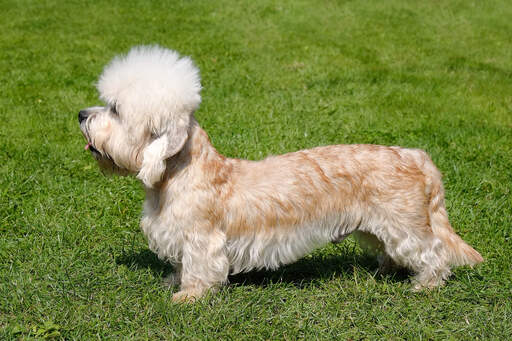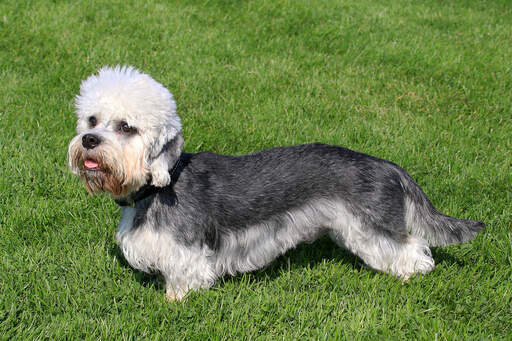Dandie Dinmont Terrier Hund






History
The Dandie Dinmont Terrier, or Dandie, originates as far back as the 1600's where it was used for hunting otters and badgers. The modern day form was first seen in the 1800's around the border country of Scotland and England. They were most likely crossed with Border, Skye and Scottish Terriers to produce the breed recognised today. Some believe that Dachshund blood was introduced, which would explain the long body.
Behaviour
Dandies are a feisty, rough and tumble dog, with a fun loving personality. Their small size hides their attitude, they are ready for anything and can be tenacious when it comes to hunting. Like most terriers, many love to dig and chase small furry animals. They are good with older respectful children and make undemanding pets; the most docile of the Terrier breeds, Dandies will happily sleep all day at your feet or on your lap if allowed. They are loving and warm towards their owners, but not constantly under your feet. If brought up with cats, they are fine, but if they see one outside, instinct will kick in and they'll chase it. They usually give strangers a warm but slightly concerned welcome. Early socialisation will help them learn that strangers are ok. With strange dogs it can be wary, rarely starting a fight, but will stand it's ground if threatened. They forget they are small dogs and are brave and will fight back if they feel the need. Training can take time, due to their stubborn, Terrier, ways. They can learn, but it will take lots of patience. Dandies only bark when they are concerned and make good watch dogs. They are slow to mature, both mentally and physically, but by 2 years old they should have reached full size. Their soulful eyes melt the hearts of owners and they use this to their advantage. Walking is best done on the lead or a safe area. They are small and can/will disappear down a rabbit or fox hole, looking for prey. The prey instinct cannot be trained out of them, that is what they were bred to do. Walks need to be regular to prevent boredom, Dandies have a surprising amount of stamina for their size.
Grooming needs to be done little and often. Brushing a couple of times a week and scissoring/shaping a few times a year. Shaping for show dogs is continual. The only real issues they can suffer from is back problems and glaucoma.
Temperament
Dandie Dinmont Terriers possess a dignified yet tenacious temperament. Calm and polite around the house the Dandie will become protective of home and family acting as a good watchdog. Definitely a big dog in a small body the Dandie won't back down from anything and will show a strongly independent nature. This can make training difficult but with plenty of positive reinforcement he will soon become obedient.
Health Problems
Health problems that may affect Dandie Dinmont Terriers include intervertebral disk disease (pressure on spinal cord that can cause paralysis) and eye problems suchas glaucoma.
Breed Details
- Status: Common
- Life Expectancy: 11 - 13 years
- Weight: 8.2 - 11 kg
- Højde: 8 - 11"
- Rare: Nej
- Coat: Medium
- Grooming Requirements: More than once per week
- Town or Country: Either
- Minimum Home Size: Small House
- Minimum Garden Size: Small to Medium Garden
- Breed Type: Pest Control Dog
- Størrelse: Lille
- Energy Level: Medium
- Exercise Required: Up to 1 hour










